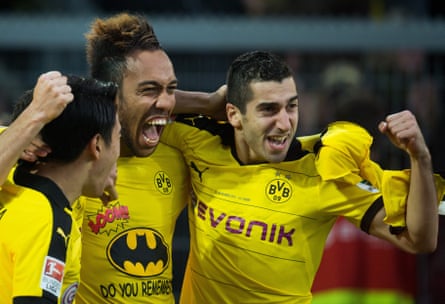A few years ago, when Jens Lehmann was in between spells as an Arsenal player and coach, he explained a key to the Invincibles team with a teasing question: “What is the fastest thing on a football pitch?” he asked cryptically, looking smug as he waited for the wrong answer. “It’s not the ball,” he added, before the big reveal: “Nobody is faster on the pitch than a thought. And then the ball comes. And then the players come. I can honestly say between 2003 and 2006 we played such fast football. One touch. It was amazing to see.”
Fast football. That is one of the aspects that has declined at Arsenal in recent years as the speedometer has dropped off. The high-velocity style Arsène Wenger encouraged when he arrived in England, the full-throttle bursts Lehmann watched take off in front of him, have become less prominent. When Arsenal struggle and slip into endless sideways probing, becoming exposed to the kind of errors and breaks that got punished so typically at Swansea, that is when they look a world away from the best Wenger teams of old.
Alexis Sánchez got fast football, with his indefatigable darting runs, sudden passes (even if they could be reckless) and the urgency he visibly demanded of others. But while he offered that individually, it is notable that Arsenal have not played with a high-speed team style for a while. That is partly because it is hard to achieve without an entire XI of extremely gifted and intelligent players. It does not help, though, that they have not reliably been built around a sprinter as their centre-forward since Thierry Henry.
In the last couple of seasons Sánchez had the odd stint as a central striker, as did Theo Walcott and occasionally Danny Welbeck. Olivier Giroud’s best asset was never pace. Alexandre Lacazette came in last summer for a record fee but is still finding his way in the team.
Enter Pierre-Emerick Aubameyang and Henrikh Mkhitaryan. By Arsenal’s normal transfer standards this has been a radical January. Bringing in these two players allows them to attempt to regain a sense of fast football.
It is underestimating Aubameyang to pigeonhole him as a speed merchant alone – his timing to peel into spaces and connections with team-mates in creating as well as running on to chances make him more rounded than that. That said, his pace should have a strong impact in how Arsenal attack. The other obvious contribution on the fast football front is the fact he is coming as part of a proven pair. The bond with Mkhitaryan, given the understanding they shared at Borussia Dortmund, brings instant automatisms to Arsenal in the final third. Mesut Özil will presumably click into that pretty easily as well.
In the last campaign that Aubameyang and Mkhitaryan played together at Dortmund, 2015-16, their combined figures were superb: 59 goals and 31 assists between them, with a lot of the goals reflecting the rapport they had with each other; one providing and the other finishing.
In the summer of 2016 Wenger went striker shopping, on the hunt for a quick frontman, but a player of the calibre and expense of Aubameyang seemed miles off the radar. He courted Jamie Vardy to no avail and ended up with a gamble on Lucas Pérez, who returned to Spain on loan after a season in which Wenger was unwilling to offer him many chances to find some rhythm.
Arsenal have tended to give the impression they improvise rather than work to some refined strategic masterplan when it comes to transfers. With this in mind, there is a concern the position of Lacazette may become a side dish as Arsenal tuck into the new and exciting main course of Aubameyang and Mkhitaryan.

It is out of character for Arsenal to spend heavily on a new striker in the summer and then six months later spend even more heavily on another one. The question of how Lacazette and Aubameyang link – whether they play together, compete for the same spot or one is shifted out of their favoured position – is an important one. Lacazette will not be thrilled if he feels he is unfairly pushed aside but, if Wenger can keep everyone happy and motivated, he has promising attacking tools at his disposal.
Constructing a new and balanced frontline, as quickly as possible, will go some way to determining how competitive Arsenal can be in the second half of the season as they adjust to life after Sánchez. The nagging issues in terms of defensive concentration will not be fixed by that but more clinical forward play could help ease some of the pressure.
At the start of the season the idea Arsenal would offload Sánchez, Giroud and Walcott in the same January window scored somewhere between fanciful and bonkers on the transfer scale. The trio scored more than two-thirds of the team’s goals last season (Sánchez 30, Giroud 16 and Walcott 19). Arsenal are usually way more conservative in the market. They cannot be accused of that this time.
Critics of Ivan Gazidis’s “catalyst for change” movement can see this January window as evidence of something new. That would have been impossible if Arsenal had flunked in their very public pursuit of Aubameyang.
The release of Sánchez never looked likely to put them in a stronger position but they have tried their utmost to turn a negative into a shiny positive. Parading the signatures of Aubameyang and a freshly contracted Özil on deadline day, in addition to the newly welcomed Mkhitaryan, outlines how Arsenal’s best (perhaps only?) form of defence has to be a fresh attack.
